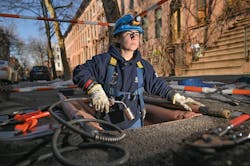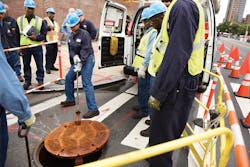Throngs of people walk, bike and drive along New York City’s streets each day, hurrying to get to work, school and transit hubs. Some are among the 65 million tourists a year who flock to New York, New York, U.S., to see iconic attractions, like top museums, the Statue of Liberty, the Empire State Building, Broadway and the financial district. Others have spent their lives in the city, attending the schools, working at companies big and small, and contributing to the unique culture of high energy and great aspirations. All have something in common: They depend on Consolidated Edison of New York Inc. (Con Edison) to keep the lights on, appliances running, and buildings heated and cooled with safe, reliable energy.
To fulfill this duty, the utility’s analysts, engineers, mechanics and supervisors constantly and vigilantly check process integrity, monitor system conditions, develop new technologies and execute public safety programs. One area of opportunity for the utility was with manhole events. Con Edison sought to evolve its strategy to prevent such events, particularly manhole explosions.
A Vast System
Con Edison serves 3.5 million customers in New York City and Westchester County, N.Y. These include 2.6 million customers who are served by an underground distribution network of primary and secondary systems with a combined 96,000 miles (155,000 km) of cable. The secondary network system consists of 120/208-V mains interconnected through 267,000 manholes and service boxes. This density of facilities and people presents unique challenges.
Smoking manholes, fires and explosions that dislodge the cover can occur for several reasons but are predominately a result of insulation degradation and eventual breakdown on secondary cable. Over decades of service, the cable and connections below the streets of New York City have experienced substantial changes in temperature; been met with debris, water and rock salt; and been impacted by vibrations from traffic and construction.
The harsh environment takes a toll on cables and connections. When insulation is damaged, current can leak out of the cable and a high impedance fault may form. At this point, the insulation burns and generates gases, some of which are combustible. Depending on a variety of factors, these gases may dissipate, migrate into buildings, catch fire, or combust and cause the cover to lift and go airborne.
Manhole Risks
The risk of manhole events for a U.S. utility in the Northeast is greatest during the winter, when public works crews place salt on the streets to melt snow and ice. The briny mix washes into the underground electric delivery system, contacting the cables and connections. Historically, the number of manhole events has correlated directly with the amount of salt distributed.
Data from the winter of 2017-2018 suggests Con Edison’s comprehensive preventive strategy is starting to improve performance. That winter, although public works crews in New York City distributed the second largest amount of salt on streets in the last 10 years, the number of manhole events per kiloton of salt was the lowest it had been in 10 years.
Statistically, explosion events are rare, occurring in about 1% of underground structures per year on average. Events that cause the cover to lift are the rarest and occur orders of magnitude less than the 1% total. Thus, engineers and analysts face a challenging problem: determining the root causes of events that rarely happen.
History of Innovation
Throughout its long history, Con Edison has put innovation and continuous improvement first. Over the last two decades, the utility expanded its comprehensive public safety program to include visual inspections, quality assurance, stray and contact voltage testing, and venting of underground structures. As with any endeavor, the utility must evaluate the program efficiency and efficacy constantly, adjusting its strategy as necessary.
At the start of the manhole inspection program, Con Edison wanted to determine whether the defects identified contributed to events and whether repairing those defects would reduce the likelihood of an event. Now, with more than 14 years of program experience and data, analysis shows the defects are not highly predictive, so the utility continues to follow its values of innovation and improvement.
A key part of Con Edison’s current strategy to maximize safety and reliability is the installation of dual-layer cable. The dual-layer cable is made from low-smoke, nonhalogenated materials, which makes it safer. For reliability, the cable is more durable with an outer jacket designed for abrasion resistance. In 2018, the utility installed approximately 890 miles (1430 km) of this new dual-layer secondary cable for mains and services. Con Edison has installed approximately 21,500 miles (34,600 km) of this cable since 2002.
Methodology
A utility can approach cable replacement in two ways: run to failure or be proactive. An intelligent, proactive cable replacement program can maintain a system-wide average age and failure rate while helping to reduce the most serious events. Con Edison’s replacement program operates on asset statistics that point toward design combinations at failing at rates greater than the system average and in ways that elevate risk.
Selection attributes include aluminum cables and vintage copper cables with a neoprene jackets. Of specific concern is when aluminum and copper cables are connected within the same structure, because oxidation can occur at the connection. From 2015 to 2018, Con Edison crews proactively replaced cable in more than 400 underground distribution structures.
Cable replacement is not the only option for cable safety and reliability, as not every main or combination of mains targeted requires replacement. Retirement in place sometimes can achieve the same objective. The deenergization of these cables, from both sides of the connection, is the most economical solution for reducing the risk of failure. In 2018, Con Edison retired more than 100 sections of cable.
The conditions required for cable retirement are as follows:
- The cable is a targeted cable based on data.
- A load-flow and design study indicates there would be no compromise to reliability under normal and contingent conditions.
- An on-site crew confirms the cables in the structure match what the system maps and models show.
Put Technology to Work
Replacing or deenergizing all targeted cable is a long-term program. Con Edison’s engineering team developed new technologies to drive down short-term risk. Structure monitoring is a prime example. The utility has developed a robust underground system of monitors, known as the structure observation system (SOS). To date, crews have installed more than 3600 SOS monitors. Each device serves as an early-warning system, through a suite of sensors that monitor temperature, humidity and combustible-gas levels. The devices also produce infrared images of the cable and connections.
When the latest version of these devices is released, Con Edison will use power-harvesting current transformers to provide connection-free constant power. The constant source of power will enable these monitors to increase their frequency of data sampling and communication.
The SOS platform is designed for simplicity: Mount the box, place the current transformers around a cable, record the serial number and power on the box. Communications are preconfigured for cellular over a private network with encryption. With monitors in a structure, continuous data sampling and an associated trending support system model adjustment and validation as well as planning decisions.
Detection and Mitigation
The detection and mitigation process rely on the acute sensory ability of the monitors and expertise of the utility’s engineers. When a sensor detects heat or gases above a predetermined threshold, the monitor instantly sends the data back to the server.
Con Edison engineers evaluate the condition and decide whether further action is required. They look at other SOS measured parameters and external operations data leading up to the condition in the structure. They determine whether the parameters show a trend that is transient or slow rising, and they look at magnitudes of the measurements. For example, an engineer might see a high ambient temperature or thermal imaging with a high temperature associated with a primary feeder that opened automatically. If the elevated temperature is not the result of an external influence, the engineer schedules a crew to repair the hot-spot condition.
The concept of hot spots is not new to Con Edison. In fact, the utility incorporated hot-spot detection capability into its SOS monitors because of success crews had finding defects with infrared (IR) cameras. A detailed article on the infrared program, written by Con Edison’s Colleen Murach, appeared in the December 2016 issue of T&D World.
To summarize the article, when crew members arrive at a structure, they scan it with an IR camera and, in some instances, take and transfer IR images of the cables and connections. They also may use ammeters to measure and capture peak currents on the mains and services. Distribution engineering staff studies the data and images to determine whether a problem exists. A problem may not be obvious. For instance, engineers may flag a cable for repair even if the temperature is below rating but significantly out of proportion to the peak amperage or surrounding temperature. In 2018, Con Edison crews mitigated almost 250 hot-spot conditions.
Latched Covers
Manhole events in which the cover becomes airborne can pose the greatest risk, particularly in a city with heavy pedestrian activity like New York. One solution Con Edison uses is latching, which keeps the cover connected to the underlying frame when pressure builds in the structure. The utility’s design goal with the latched cover was simplicity. Con Edison wanted it to be easy to install and remove the cover, requiring no special tools. The utility’s engineers worked with cover suppliers, academia, and field crews to model and simulate explosions, develop latching mechanisms and optimize performance.
One latched cover design Con Edison uses enables the cover to lift slightly on all sides in response to pressure in the structure and then settle back into place once the internal and external pressures have equalized. The other latch design on the system enables the cover to lift slightly on one side while remaining hinged on the opposite side. Con Edison has installed 750 latched covers and continues to deploy them.
Structure Space
Con Edison also found reducing the space in structures where combustible gases can accumulate has the potential to eliminate or significantly reduce the energy of an explosion. Utilities in the U.K. have filled underground structures with sand and had positive results. However, sand would be impractical for Con Edison crews.
The engineering team came up with another idea, focused on application and design simplicity. It is the placement of durable bags, or pillows, of perlite — a light-fill material found in potting soil — into structures. These bags, which crews can install and remove with minimal effort, occupy about 50% of the free space. Con Edison has placed bags of perlite in more than 100 underground structures.
Work Continues
Other strategies are evolving. Con Edison currently is reevaluating limiter sizing and usage to clear faults quicker and provide better sectionalizing. The utility also is exploring the use of “smart crabs” to provide loading and operational information to the SOS monitors.
A crab is a point of connection for low-voltage cables. A smart crab transforms this equipment into a point of connection and measurement for current and temperature.
Safeguarding the public and workers while providing power in the nation’s densest urban environment is a great responsibility—one the 14,000 men and women of Con Edison proudly embrace. The utility has deployed a comprehensive strategy on manhole events and is getting results. Emerging technologies promise to bring greater insight into system conditions and performance. Sound engineering will lead to continued improvements and a safer New York.
For more information:
Con Edison | https://coned.com










